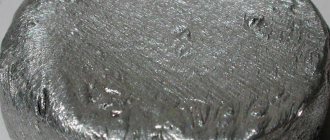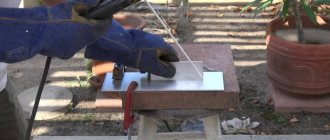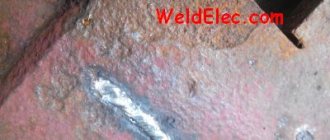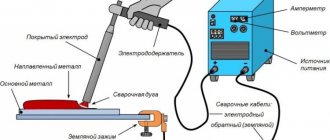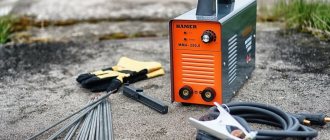Welding aluminum is complicated by many factors (primarily its characteristics), but specialists are constantly working to improve technologies that make it possible to reliably connect parts made of this metal and its alloys. Aluminum itself and its alloys are distinguished by truly unique properties: low specific gravity, high electrical and thermal conductivity, and resistance to mechanical loads.
Aluminum welding process
What explains the poor weldability of aluminum?
The difficulties and features of welding aluminum and its alloys are explained by a number of unique properties of this metal.
- The main difficulty in heat treatment of aluminum is that the surface of this metal is always covered with an oxide film, which has a very high melting point - 20440 (the metal itself melts at a much lower temperature - 660 degrees).
- Drops of molten aluminum that form in the welded zone are instantly covered with a refractory oxide film, which prevents the formation of a continuous seam. This determines some features of aluminum welding: the welded zone is reliably protected from interaction with the surrounding air, for which argon gas is used.
- In the molten state, aluminum has high fluidity, which seriously complicates the process of forming a weld pool. That is why aluminum welding technology involves the use of special heat-dissipating pads.
- Aluminum contains dissolved hydrogen, which tends to escape when the molten metal solidifies. This contributes to the formation of pores in the weld, as well as crystallization cracks. In addition, the alloys of this metal are characterized by a high silicon content, which also contributes to the formation of cracks that occur when parts cool.
A crack in a weld resulting from a violation of the work technology
- Aluminum has a decent linear expansion coefficient. For this reason, significant shrinkage of the metal occurs when it solidifies, which leads to serious deformations of the parts being connected.
- Welding of aluminum and its alloys is carried out at high values of welding current. This is explained by the fact that this metal has high thermal conductivity. It is noteworthy that when welding steel (and its melting point is higher than that of aluminum), lower currents are used (1.2–1.5 times).
- Welding parts made of this metal (especially welding aluminum at home) is often difficult because it is very difficult to determine the exact grade of alloy from which the parts being joined are made. This seriously complicates the choice of welding modes and methods used to perform it.
Advantages and disadvantages
As mentioned earlier, welding aluminum is not an easy task and requires a certain skill and knowledge. However, this type of work is still in demand. The only explanation for this is the quality of manufactured parts and structures, despite belonging to the group of light metals.
Moreover, aluminum is so highly valued in industry that almost any tool necessarily includes this substance.
The advantages of cooking include the following:
- This process does not require much time, and the product of your activity can be seen a few minutes after the end of welding;
- This type of work is considered budget-friendly because it does not require the master to have any special equipment;
- Lack of a scale assessing the quality of the resulting seam;
- The result is a strong, seamless seam.
The disadvantages include the following:
- Despite the lack of criteria and requirements, the seam is still of poor quality;
- It is difficult to follow all the TB rules;
- From time to time, a specialist is faced with a problem in choosing auxiliary materials.
What methods are used for welding aluminum
For welding aluminum, different methods can be used, involving the use of various materials and equipment, and special means to protect the welding zone (inert gases and fluxes).
Comparative assessment of welding types (click to enlarge)
Among the methods for performing aluminum welding both at home and in industrial conditions, the following are most widespread:
- welding carried out in an inert gas environment using a tungsten electrode (AC TIG);
- semi-automatic welding, also carried out in a protective gas environment, for which a special wire fed in an automated mode (DC MIG) is used;
- welding, which uses electrodes coated with a special compound (MMA).
When asking yourself the question of how to weld aluminum to obtain a reliable connection, it is important to understand that this requires destroying the oxide film that forms on the surface of the metal. To solve this problem, direct current is used for welding, and the polarity is reversed. In this case, the effect of cathode sputtering is achieved, with the help of which it is possible to destroy such a refractory film.
It is impossible to weld aluminum with direct current using straight polarity: under such conditions the effect of cathode sputtering is not created.
Necessary equipment
It is logical that to carry out work of this kind, the use of equipment is mandatory. First of all, it is necessary to ensure suitable conditions and prevent the occurrence of traumatic situations.
Moreover, it is necessary that this equipment helps control the energy transformation process.
For welding using gas, you will need an element with a gas supply, a cylinder with the necessary gas, a reducer and gas hoses.
How to prepare metal for welding
Regardless of the conditions in which aluminum parts are welded - industrial or domestic, it is necessary to carefully prepare the edges of these parts. Such preparation is as follows.
- The surfaces of the parts to be welded (as well as the filler material) are cleaned of dirt, oil and grease. To degrease surfaces, they are treated with white spirit, acetone, aviation gasoline and any other solvent.
- Preparation also includes cutting the edges of the parts to be welded, which is performed if necessary. If welding of parts made of this metal is not carried out using coated electrodes, then the edges should be cut when the thickness of the parts being joined exceeds 4 mm. If electrodes are used for welding, then edge cutting is performed when the thickness of the parts exceeds 20 mm. If aluminum sheets with a thickness not exceeding 1.5 mm are to be welded, then their ends are flanged before making the connection.
- The oxide film must be removed from the surface of parts made of this metal before welding. For this procedure, a file or brush with stainless steel bristles is used, with the help of which the oxide film is removed from the edges of the workpieces being joined (25–30 mm wide).
Treatment of the welding site with a penetrating compound in order to identify defects and determine the location of the seam
Often, when welding aluminum at home, chemicals are used to remove the oxide film: caustic soda, gasoline. If the edges of the parts to be joined are treated with caustic soda, after such treatment it is necessary to rinse them with running water.
Welding using specially coated electrodes
Electrodes with a special coating are used to weld aluminum structures, which are not subject to increased requirements for reliability and strength of the connection. Most often, this is the method used to weld aluminum with your own hands in home workshops. The main disadvantages of this welding method (it is used to connect parts whose thickness exceeds 4 mm) include:
- low strength of the weld, as well as its high porosity;
- intense splashing of molten metal;
- the separation of slag from the weld surface is quite difficult, which can cause corrosion of the latter.
Using coated electrodes and appropriate equipment, it is possible to weld parts from both technically pure aluminum and alloys of this metal. The most popular brands of electrodes, with which you can weld almost all types of aluminum alloys, are UANA and OZANA, which replaced the outdated OZA-1 and OZA-2.
Electrodes of the OZANA-1 brand are optimally suited for welding pure aluminum, and OZANA-2 - for joining workpieces made of alloys of this metal with silicon (AL-4, AL-9, AL-11).
Kobatek electrodes for welding aluminum alloys
Using such electrodes, welding work is performed using direct current, connected in reverse polarity, which should be taken into account when choosing equipment for performing work in industrial and home conditions. To select the value of the welding current, you can use a simple rule: 25–30 A direct current is required per 1 mm of electrode diameter.
When welding parts characterized by medium and large thickness, pre-heating of the parts being joined is necessary, for which you can use a gas torch. When it is necessary to weld parts of significant thickness, local heating of the future joint is performed. The use of preheating of parts (from 250 to 4000 - depending on the thickness of the metal), as well as slow cooling, allows you to effectively melt the metal even when welding at low currents, minimizing the risk of crystallization cracks and deformation of the finished structure.
Since aluminum electrodes melt quite quickly, welding work should be performed at high speed. It is very important to ensure continuity of welding carried out using one electrode. Breaking the arc in this case will result in the end of the electrode and the weld crater being covered with a slag crust, which prevents re-ignition.
It should also be taken into account that when welding aluminum, the electrode does not undergo transverse vibrations.
Slag should be removed as soon as welding is completed. Then you need to rinse the cleaned seam with hot water, and then treat it with a wire brush. This is done in order to remove slag residues from all corners of the seam (otherwise it can become a source of development of corrosion processes).
Welding using this technology is used primarily for work in home workshops and small repair shops. For such welding you do not have to purchase expensive equipment or consumables, but it is not recommended to perform important work with its help. What’s convenient is that you can even use equipment that you made yourself.
Grades of aluminum alloys most used for welding
Aluminum alloys are classified into two groups: thermally hardenable and, accordingly, not thermally hardenable. Among the grades that cannot be thermally hardened, aluminum-magnesium alloys of the AMG grade are used for welding. Their chemical composition corresponds to GOST 4784, and the assortment of sheets corresponds to GOST 1946. See table:
Brand
| Essential elements, % | Impurities, % | |||||||
| Mg | Mn | V | Si | Ti | Be | Cu | Zn | |
| AMg | 2,0-2,8 | 0,15-0,4* | — | 0,4 | — | — | 0,4 | 0,1 |
| AMg3 | 3,2-3,8 | 0,3-0,6 | — | 0,5-0,8 | — | — | 0,5 | 0,05 |
| AMg5p | 4,7-5,7 | 0,2-0,6 | — | 0,4 | — | — | 0,4 | 0,2 |
| AMg5n | 4,8-5,5 | 0,3-0,6 | 0,02-0,2 | 0,5 | — | — | 0,5 | 0,05 |
| AMg6m | 5,8-6,8 | 0,5-0,8 | — | 0,4 | 0,02-0,1 | 0,0001-0,005 | 0,4 | 0,1 |
| AMg6t | 6,0 | According to TU OP38-56 | — | — | — | — | — | |
| Designations: semi-hardened; m-annealed; n-cold-hardened; t-hardened and subject to natural aging. * or chromium in the same ratio | ||||||||
With an increase in the percentage of magnesium to 7%, the weldability of metals deteriorates. With a magnesium content of up to 3%, the risk of cracking increases, but the weld becomes more dense.
To reduce the number of pores in the weld, filler wire is selected, in which the magnesium content is higher than in the metal being welded. Due to this, the porosity of the seam is reduced.
For welding high-strength structures, heat-treatable aluminum alloys - duralumin - are used. Duralumin grades D1, D16 and D19 are widely used in fusion welding. Alloy D20 belongs to the satisfactory weldability group of steels.
Magnesium-aluminum alloys with an aluminum content of up to 11% are welded satisfactorily by fusion welding. And with a welding method such as resistance welding, the weldability of these metals is good.
Welding with shielding gas
Aluminum welding, which involves the use of shielding gas, can be considered the most common technology. It allows you to obtain connections that are highly reliable, durable and aesthetically pleasing.
Aluminum rods (filler) for welding
The main consumables for welding using this technology are tungsten electrodes (Ø 1.6–5 mm) and rods (Ø 1.6–4 mm), used as an additive. Shielding gases can be helium or argon, which are of high purity.
Effective destruction of the oxide film, which is necessarily present on the surface of the workpieces being joined, is ensured by powering the welding arc from a source producing alternating current. All modes of the welding process, which depend on the type of connection being made and the thickness of the parts being joined, are selected according to special tables. Such modes, in particular, include the diameter of the tungsten electrode, as well as the filler rod, the magnitude of the welding current, and the speed at which the shielding gas is supplied.
Approximate welding parameters when working with argon
Having the appropriate equipment and consumables, welding using this technology can be successfully performed at home, using it to obtain high-quality, beautiful and reliable connections. To learn how to perform shielded gas welding with your own hands, you can watch a training video and remember a few simple rules for its implementation.
- An angle of 70–80 degrees should be maintained between the tungsten electrode and the horizontal surface of the parts being connected.
- The angle between the tungsten electrode and the filler rod should be about 90 degrees.
- The arc length should be in the range of 1.5–2.5 mm.
- When forming a seam, the filler rod moves first, followed by the torch (this ensures effective protection of the weld).
- The filler rod is fed into the welding zone as if you were holding a brush in your hands and using it to paint a picture. The tip of the filler rod is brought to the edge of the weld pool, touching it, and then pulled back and up. Transverse movements of the electrode and filler rod, which is important, are not recommended. You can study this process very well using the appropriate video.
- To prevent overheating of the parts being joined and burning through thin sheets, as well as to ensure rapid heat removal from the welding zone, a steel or copper lining is placed under them to act as a radiator.
- The supply of shielding gas to the welding zone is turned on a few seconds before the start of welding (3–5), and the supply is turned off some time (5–7 seconds) after the arc breaks.
When welding aluminum parts in a shielded gas environment, it is necessary to very carefully monitor process parameters such as welding speed and gas consumption, as they have a serious impact on the quality of the weld being formed. If the gas flow is too high, for example, air will be sucked into the welding zone, which will worsen its protection. Effective protection of the welding zone will also not be provided if the gas flow is too low and the connection speed is too high.
Obviously, if you have the appropriate equipment and skills to perform such work, it is quite possible to weld aluminum parts with your own hands using this technology in a home workshop or garage.
Safety precautions
This type of activity belongs to the group of trauma-hazardous processes. Therefore, you should strictly follow the prescribed rules to avoid causing harm to others.
It should be remembered that:
- The specialist must wear: a special suit, a mask, thick gloves, shoes with rubber soles;
- The electrical circuit must be isolated and inaccessible;
- Welding can only be carried out in clean areas. It is prohibited to carry out work in the presence of flammable objects;
- The work area must have good ventilation to avoid gas poisoning.

